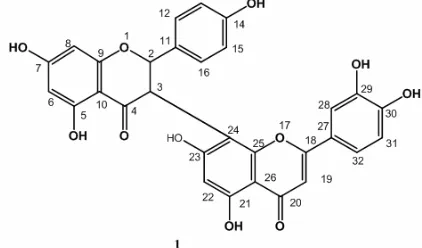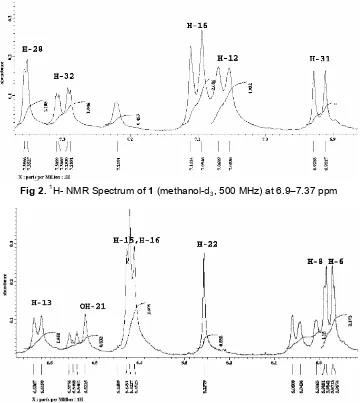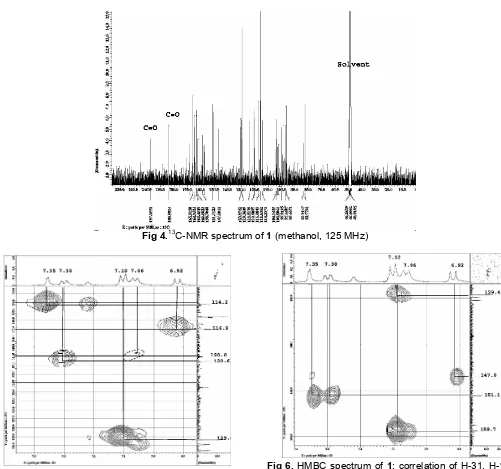Indo. J. Chem., 2011, 11 (2), 169 - 173
169
BIFLAVONOID COMPOUND FROM THE STEM BARK OF GAMBOGE
(Garcinia xanthochymus)
Muharni
*, Elfita, and Amanda
Department of Chemistry, Faculty of Mathematics and Natural Science, Sriwijaya University, Indralaya, South Sumatera, Indonesia
Received March 17, 2011; Accepted July 15, 2011
ABSTRACT
Garcinia xanthochymus (Guttiferae) commonly known as gamboge, is a perennial medicinal plant native to the north of Thailand and Myanmar. Gamboge is used in watercolors, as a yellow fabric dye and traditional medicine for treating diarrhea and dysentery, dispelling worms clearing away fire and removing food toxin. Phytochemical investigations on the methanol extract of the stem bark of Garcinia xanthochymus resulted in isolation of one biflavonoid compound (+)-morelloflavon. The structure of this compound was deduced on basis of spectroscopic data including1H NMR,13C NMR, HMQC and HMBC and comparison with the reported data. This compound has been reported from others species of Garcinia.
Keywords:Garcinia xanthochymus, biflavonoid, (+)-morelloflavon
INTRODUCTION
Garcinia xanthochymus (Guttiferae) commonly known as gamboge, is a tree endemic to india growing 8–10 m in height and is a perennial medicinal plant native to the north of Thailand and Myanmar [1]. Gamboge is used in watercolors and as a yellow fabric dye. Gamboge fruit are used in traditional medicine for treating diarrhea and dysentery; dispelling worms clearing away fire and removing food toxin .Plants in the guttiferae are rich sources of xanthones, biflavonoids and benzophenones [2]. These constituents have been reported to possess several biological activities, such as antibacterial activity, antimalarial activity, cytotoxicity analgetic, antioxidant, antiviral and neurotrophic activity and inhibition of cyclooxygenase. Previous phytochemical studies of G. xanthochymus have show the presence of 1,3,5,6-tetrahydroxy-4,7,8-(3-methyl-2-butenyl)xanthone, garciniaxanthone, 1,4,5,6-tetrahydro xy-7,8-di(3-methylbut-2-enyl)xanthone and 1,2,6-trihydro xy-5-methoxy-7-(3-methylbut-2-enyl)xanthone from the wood [3,4], xanthochymol, isoxanthochymol, volkensi flavone, 1,5-dihydroxyxanthone and 1,7-dihydroxyxan thone from the fruits [1], and 1,6-dihydroxy-4,5-dimethoxyxanthone and 1,5,6-trihydroxy-7,8-di(3-methyl-2-butenyl)- 6’,6’-dimethylpyrano(2’,’3:3,4)xanthone from the bark ofG. xanthochymus [5]. The CHCl3and EtOAc
partitions from G. xanthochymusfruits displayed activity in the DPPH assay (IC50 = 32 and 105 ug/mL respectively and cytotoxicity against the SW-480 colon cancer cell line (IC50= 15 and 50 µg/mL respectively
In our continuing phytochemical investigation of
G.xanthochymus a biflavonoid compoud, (+)- morello
flavone (1), was isolated from the methanol extract of the stem bark of G.xanthochymus. In this paper, we describe the isolation and structural elucidation of the isolated compounds. The compound was identified by their spectra data and comparison with the reported data.
EXPERIMENTAL SECTION
Plant material
The stem bark ofG.xanthochymus were collected from Hutan Raya Bogor, West Java, Indonesia. This plant was identified and voucher specimen has been deposited in the Herbarium Bogoriensis Bogor.
Materials
Vacuum liquid chromatography (VLC) and column chromatography were carried using Merck silica gel 60 GF254(230-400 mesh)), column chromatography using
Indo. J. Chem., 2011, 11 (2), 169 - 173
170
Fig 2.1H- NMR Spectrum of1(methanol-d3, 500 MHz) at 6.9–7.37 ppm
Fig 3.1H- NMR Spectrum of1(methanol-d3, 500 MHz) at 5.02–6.66 ppm
Si gel 60 (70–230 mesh.). Analytical thin layer chromatography (TLC) was carried out using Merck (Art.5554) silica gel 60 F254, pre-coated aluminium
sheets solvents for chromatography were technical grade and distilled before use.
Instrumentation
Melting point was determined on a micromelting point apparatus NMR spectra were recorded at 500 MHz (1H) and 125 MHz (13C) on JEOL JNM ECA-500 spectrometer. Organic materials were detected by first viewing the plate under UV light at 254 nm and 365 nm. The extracts were organic mixture samples were applied in the pre-adsorbed form on silica gel 60 (70–230 mesh.)
Procedure
Extraction and isolation
The dried powdered of the steam bark of
G.xanthochymus (2 kg) was macerated sequentially with n-hexane, EtOAc, and methanol at room temperature. Concentrated in vacuo to evaporate and give n-hexane (30 g), EtOAc (40 g), and methanol (35 g). The methanol extract (30 g) was further fractionated by vacuum liquid chromatography (VLC) with gradient elution, using n-hexane–EtOAc (8:2 – 2:8)
Indo. J. Chem., 2011, 11 (2), 169 - 173
171
Fig 4.13C-NMR spectrum of1(methanol, 125 MHz)
Fig 5.HMQC spectrum of1:31, 16, 18, 32, H-28 (methanol-d3, 500 MHz)
Fig 6.HMBC spectrum of 1: correlation of H-31, H-16, H-18, H-32, H-28 with carbon at C129 -160 ppm
(methanol-d3, 500 MHz)
RESULT AND DISCUSSION
The methanol extract from the dried stem bark of
G. xanthochymus has been isolated a. bilfavonoid as (+)-morelloflavon (1) as yellow crystal, m.p 300–301 °C. The H-NMR spectrum (Table 1) of 1 showed the presence of there aromatic proton atδH6.92 (H-31) (1H,
d, J = 8.45 Hz), δH 7.30 (H-32) (1H, d, J = 1.95; 8.45)
and 7.35 (H-28) (1H, d, J = 1.95). Characteristic for 1,3,4-trisusbtituted benzene (Fig. 2).
One signal singlet also observed in this spectrum at δH6.26 (H-22) (1H, s). In the
1
H NMR spectrum the
presence of signal- signal proton aromatic at δH 5.97
(H-6) (1H,d, J= 1.9) andδH5.98 (H-8) (1H,d, J= 1.9)
showed coupling metha, two pairs proton coupling ortho atδH7.06 (H-12) (1H,d, J= 8.4),δH6.62 (H-13)
(1H, d, J = 8.4) and δH 6.42 (H-15) (1H, d, J = 8.45)
andδH 7.10 (H-16) (1H,d, J= 8.45). Signal doublet at
δHδH5.76 (1H,d, J= 12.3 Hz) showed coupling proton
trans axial-axial at C SP3(Fig. 3). Coupling proton trans axial-axial at C SP3usually to had constanta coupling (J) 8-14 Hz [6].
Support for the structure 1 was obtained from
13
Indo. J. Chem., 2011, 11 (2), 169 - 173
172
Table 1.1H NMR (500 Mhz),13C NMR (125 MHz), HMQC and HMBC data for 1 in methanol-d3 and comparison morelloflavon* has been reported [7].
No C C(ppm)
Morelloflanone*
C(ppm)
1
H(ppm), integration,
multiplicity,J(Hz) 1
HMBC
15 114.4 115.6 6.42 (1H,d,8.5) C-13,C-14, C-16
16 128.1 129.4 7.10 (1H,d, 8.5) C-2, C-14
Fig 7.Selected HMBC correlation andδ-assignment of1
spectrum revealed the presences of 32 carbon resonances due to two carbonyl carbon atδC183.9 and
δC 197.9, 28 Aromatic carbon, and two carbon
SP3.signal atδC82.8 andδC48.8 ppm (Fig. 4).
The position of the proton was assigned from HMQC and HMBC spectrum (Fig. 5 and 6). Aromatic proton at δH 7.06 (d, J = 8.4) in spectrum HMBC
coupled with proton at δH 7.06 as meta coupling so, it
can be placed at C-13 position and at HMBC spectrum showed correlation {2J : C-14 (δC 158.7);
at C-32, C-28 and C-31 respectively with ortho and metha position in HMBC spectrum showed correlation with carbon [3J : C-28 (δC 114.2), C-30 (δC 151.1)];
Indo. J. Chem., 2011, 11 (2), 169 - 173
173
indicated the placed of C-6 and C-8. Two sharp singlet of two proton each at δH 6.42 and δH 6.26 showed
aromatic proton at C-19 and C-22. Signal doublet at δH 5.75 (J = 12.3) showed correlation at carbon
[3J: C-16)] and indicated the place at C-2 (δC82.8). Two
proton aromatic each atδH6.42 (d,J = 8.5) andδH7.10
(d, J= 8.5) so be coupling metha and HMBC spectrum showed correlation with carbon at C-13 (3J); C-14, C-16 (2J) and C-2, C-14 (3J) respectively which indicated the placed of C-15, and C-16. HMBC spectrum showed at Fig. 5 and 6.
According to analyzation of spectroscopy data above this compound 1 is (+)-morelloflavone. This compound had been reported from alcoholic extract of leaves of G. nervosa [7], the fruit of G. dulcis [8] and from methanol extract the bark of G. multiflora. This compound showed radical scavenging and antibacterial activities [9]. Selected HMBC correlation and δ-assignment of1showed Fig. 7.
CONCLUSION
A biflavonoid, (+)- morelloflavon had been isolated from methanol extract of the stem bark of Garcinia xanthochymus. This compound adds kinds of phytochemistry studies from the stem bark of G. xanthochymus.
ACKNOWLEDGEMENT
The authors thank at the Herbarium Bogoriensis, Bogor for identification of the plant specimen and research Center of Chemistry LIPI, Puspitek, Serpong for measuring spectra.
REFERENCES
1. Whitmore, M.A., 1973, Tree Flora of Malaya, Forest Department, Manistry of Primary Industries, Malaysia, Longman.
2. Baggett, S., Protiva, P., Eugene, P.M., Yang, H., Ressler, T.E., and Basile, M.J., 2005,J. Nat. Prod., 68, 354-360.
3. Chanmahasthien, W., Li, Y., Satake, M., Oshima, Y., Ishibashi, M., Ruangrungsi, N., and Ohizumi, Y., 2003,Chem. Pharm. Bull, 51, 11, 1332–1334. 4. Chanmahasthien, W., Li, Y., Satake, M., Oshima,
Y., Ishibashi, M., Ruangrungsi, N., and Ohizumi, Y., 2003,Phytochem., 64, 981–986.
5. Zhong, F.F., Chen, Y., Mei, Z.N., and Yang, G.Z., 2007,Chin. Chem. Lett., 18, 849–851.
6. Breitmaier, E., 1993,Structure Elucidation by NMR in Organic Chemistry, A Practical Guide, England, John Wiley & Sons Ltd.
7. Duddeck, G., Snatzke, G., and Yemul, S.S., 1978,
Phytochem., 17, 1369–1373.
8. Babu, V., Ali, S.M., Sultana, S., and Ilyas, M., 1988,Phytochem.,27, 10, 3332–3335.



![Table 1. 1H NMR (500 Mhz), 13C NMR (125 MHz), HMQC and HMBC data for 1 in methanol-d3 and comparisonmorelloflavon* has been reported [7].No CHMBC](https://thumb-ap.123doks.com/thumbv2/123dok/872180.820852/4.595.74.538.145.680/table-nmr-hmqc-hmbc-methanol-comparisonmorelloflavon-reported-hmbc.webp)